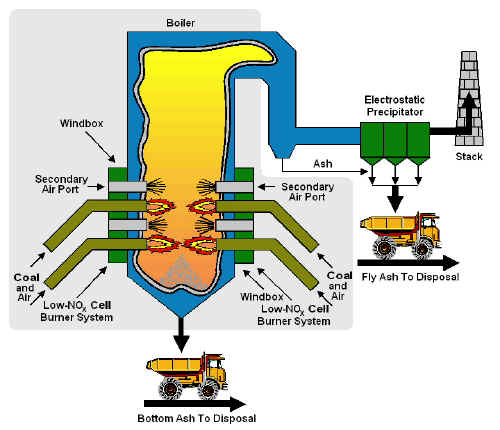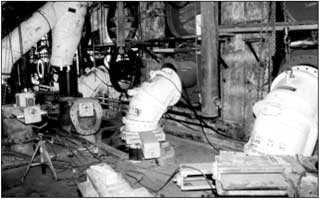
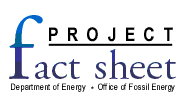 |
Full-Scale Demonstration of Low-NOx Cell Burner RetrofitEnvironmental Control Devices
|
|
| |
|
Participant Location Plant Capacity/Production Coal Technolgy |
|
Additional Members | |||||||
| |||||||||
|
LNCB is a registered trademark of The Babcock & Wilcox Company. | |||||||||
 Project Objective
Project Objective
To demonstrate, through the first commercial-scale full burner retrofit, the cost-effective reduction of NOx from a large baseload coal-fired utilityboiler with LNCB® technology; to achieve at least a 50% NOx reduction without degradation of boiler performance at less cost than that of conventional low-NOx burners.
Technology/Project Description
The LNCB® technology replaces the upper coal nozzle of the standard two-nozzle cell burner with a secondary air port. The lower burner coal nozzle is enlarged to the same fuel input capacity as the two standard coal nozzles. The LNCB® operates on the principle of staged combustion to reduce NOx emissions. Approximately 70% of the total air (primary, secondary, and excess air) is supplied through or around the coal-feed nozzle. The remainder of the air is directed to the upper port of each cell to complete the combustion process. The fuel-bound nitrogen compounds are converted to nitrogen gas, and the reduced flame temperature minimizes the formation of thermal NOx.
The demonstration was conducted on a Babcock & Wilcox-designed, supercritical, once-through boiler equipped with an electrostatic precipitator (ESP). This unit, which is typical of cell burner boilers, contained 24 two-nozzle cell burners arranged in an opposed-firing configuration. Twelve burners (arranged in two rows of six burners each) were mounted on each of two opposing walls of the boiler. All 24 standard cell burners were removed, and 24 new LNCB® were installed. Alternate LNCB® on the bottom rows were inverted, with the air port then being on the bottom to ensure complete combustion in the lower furnace.
Results Summary
Environmental
-
Short-term optimization testing (all mills in service) showed NOx reductions in the range of 53.0-55.5%, 52.5-54.7%, and 46.9-47.9% at loads of 605 MWe, 460 MWe, and 350 MWe, respectively.
-
Long-term testing at full load (all mills in service) showed an average NOx reduction of 58% (over 8 months).
-
Long-term testing at full load (one mill out of service) showed an average NOx reduction of 60% (over 8 months).
-
CO emissions averaged 28-55 ppm at full load with LNCB® in service.
-
Fly ash increased, but ESP performance remained virtually unchanged.
Operational
-
Unit efficiency remained essentially unchanged.
-
Unburned carbon losses (UBCL) increased by approximately 28% for all tests, but boiler efficiency loss was offset by a decrease in dry gas loss due to a lower boiler economizer outlet gas temperature.
-
Boiler corrosion with LNCB® was roughly equivalent to boiler corrosion rates prior to retrofit.
Economic
-
Capital cost for a 600-MWe plant was $9/kW (1994$).
-
Levelized cost for a 600-MWe plant was estimated at 0.284 mills/kWh and $96.48/ton of NOx removed.
Project Summary
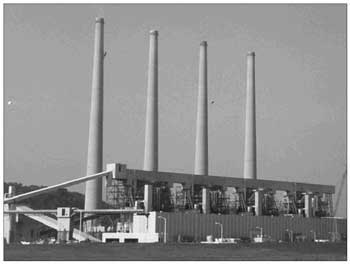 |
|
Dayton Power and Light Company's J.M. Stuart Plant hosted the successful demonstration of LNCB® technology.
|
Utility boilers equipped with cell burners currently comprise 13% or approximately 23,000 MWe of pre-NSPS coal-fired generating capacity. Cell burners are designed for rapid mixing of the fuel and air. The tight burner spacing and rapid mixing minimize the flame size while maximizing the heat release rate and unit efficiency. Combustion efficiency is good, but the rapid heat release produces relatively large quantities of NOx.
To reduce NOx emissions, the LNCB® has been designed to stage mixing of the fuel and combustion air. A key design criterion was accomplishing delayed fuel-air mixing with no modifications to waterwall panels. A plug-in design reduces material costs and outage time required to complete the retrofit, compared to installing conventional, internally staged low-NOx burners. LNCB® provides a lower cost alternative to address NOx reduction requirements for cell burners.
Environmental Performance
The initial LNCB® configuration resulted in excessive CO and H2S emissions. Through modeling, a revised configuration was developed to address the problem without compromising boiler performance. The modification was incorporated and validated model capabilities.
Following parametric testing to establish optimal operating modes, a series of optimization tests were conducted on the LNCB® to assess environmental and operational performance. Two sets of measurements were taken, one by Babcock & Wilcox and the other by an independent company, to validate data accuracy. Consequently, the data provided is a range reflecting the two measurements.
The average NOx emissions reduction achieved at full load with all mills in service ranged from 53.0% to 55.5%. With one mill out of service at full load, the average NOx reduction ranged from 53.3% to 54.5%.
Average NOx reduction at intermediate load (about 460 MWe) ranged from 52.5% to 54.7%. At low loads (about 350 MWe), average NOx reduction ranged from 46.9% to 47.9%.
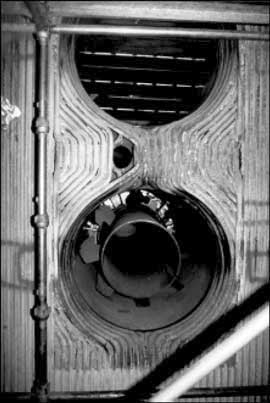 |
|
The LNCB® is viewed from within the boiler. |
NOx emissions were monitored over the long-term at full load for all mills in service and one mill out of service. Each test spanned an 8-month period. NOx emission reductions realized were 58% for all mills in service and about 60% for one mill out of service.
Complications arose in assessing CO emissions relative to baseline because baseline calibration was not refined enough. However, accurate measurements were made with LNCB® in service. CO emissions were corrected to 3.0% O2 and measured at full, intermediate, and low loads. The range of CO emissions at full load with all mills in service was 28-55 ppm and 20-38 ppm with one mill out of service. At intermediate loads (about 460 MWe), CO emissions were 28-45 ppm and at low loads (about 350 MWe), 5-27 ppm.
Particulate emissions were minimally impacted. The LNCB® had little effect on flyash resistivity, largely due to SO3 injection, and therefore ESP removal efficiency remained very high. Baseline ESP collection efficiencies for full load with all mills in service, full load with one mill in service, and intermediate load with one mill out of service were 99.5%, 99.49%, and 99.81%, respectively. For the same conditions, in the same sequence with LNCB® in operation, ESP collection efficiencies were 99.43%, 99.12%, and 99.35%, respectively.
Operational Performance
Furnace exit gas temperature, or secondary superheater inlet temperature, initially decreased by 100° F but eventually rose to within 10° F of baseline conditions.
The UBCL increased by approximately 28% for all tests. The most significant increase from baseline data occurred for a test with one mill out of service. A 52% increase in UBCL resulted in an efficiency loss of 0.69%.
Boiler efficiency showed very little change from baseline. The average for all mills in service increased by 0.16%. The higher post-retrofit efficiency was attributed to a decrease in dry gas loss with lower economizer gas outlet temperature (and subsequent lower air heater gas outlet temperature), offsetting UBCL and CO emission losses. Also, increased coal fineness mitigated UBCL.
Because sulfidation is the primary corrosion mechanism in substoichiometric combustion of sulfur-containing coal, H2S levels were monitored in the boiler. After optimizing LNCB® operation, levels were largely at the lower detection limit. There were some higher local readings, but corrosion panel tests established that corrosion rates with LNCB® were roughly equivalent to pre-retrofit rates.
Ash sample analyses indicated that ash deposition would not be a problem . The LNCB® ash was little different from baseline ash. Furthermore, the small variations observed in furnace exit gas temperature between baseline and LNCB® indicated little change in furnace slagging. Start-up and turndown of the unit were unaffected by conversion to LNCB®.
Economic Performance
The economic analyses were performed for a 600-MWe nominal unit size and typical location in the midwest United States. A medium-sulfur, medium-volatile bituminous coal was chosen as the typical fuel. For a baseline NOx emission level of 1.2 lb/106 Btu and a 50% reduction target, the estimated capital cost was $9/kW (1994$). The
|
|
|
The connections to the LNCB® are viewed from outside the boiler. |
levelized cost of electricity was estimated at 0.284 mills/kWh or $96.48/ton of NOx removed.
Commercial Applications
The low cost and short outage time for retrofit make the LNCB® design the most cost-effective NOx control technology available today for cell burner boilers. The LNCB® system can be installed at about half the cost and time of other commercial low-NOx burners.
Dayton Power & Light has retained the LNCB® for use in commercial service. Seven commercial contracts have been awarded for 172 burners, valued at $24 million. LNCB® have already been installed on more than 4,600 MWe of capacity.
The project received R&D magazine's 1994 R&D Award.
Contacts
ROGER KLEISLEY
B&W Service Company
90 East Tuscarawas
Ave
PO Box 665
Barberton, Oh 44203-0665
(330)
860-1129
330-860-1909 (fax)
kleisler@pgg.mcdermott.com
Lawrence Saroff, DOE/HQ, (301) 903-9483 lawrence.saroff@hq.doe.gov
James U. Watts, NETL, (412) 386-5991 mailto:watts@fetc.doe.gov

